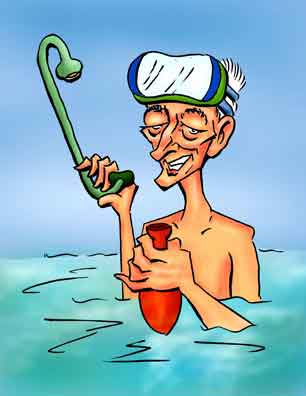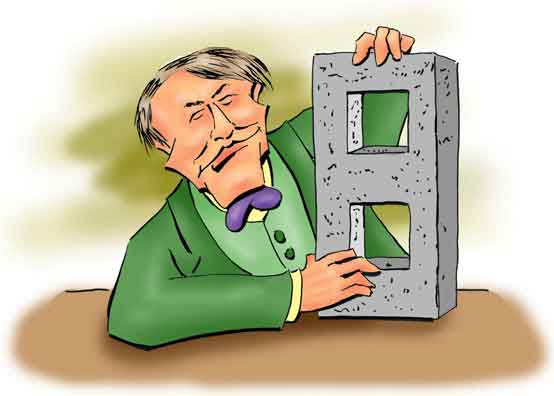Jacques Yves Cousteau
Un Étudiant Terrible

Jacques Yves Cousteau
(It should have a hyphen.)
No, Jacques Yves Cousteau was not a good student ("Yves" is pronounced "eevz"). He was disruptive - he was credited with 17 smashed windows in the school - and - we must say it - lazy. He ended up getting booted out of his collège - that is the French equivalent of middle school - and it looked like Jacques was going to be a ne-er-do-well just like ...
Well, never mind.
So Papa Daniel Cousteau decided to take his son and "straighten him out" to use a phrase preferred by Southwesterners of particular follicular sparcity. So he shipped young Jacques off to a very strict lycée in Alsace. Although not exactly a military school, it was pretty close.
Not that Jacques was lazy regarding all subjects. He showed an interest in oceanography from an early age, as well as in the burgeoning field of motion picture photography. As a teenager, he even owned a movie camera - an unusual device in the 1920's.
To everyone's surprise - including Jacques - the high school did indeed "straighten him out". He did well and buckled down on his studies. But decided he'd had enough egghead schooling. So he enrolled in the French naval academy and became 2nd Lieutenant Jacques-Yves Cousteau as a qualified pilot.
However, suddenly there was a clé angalise tossed into Jacques' career path. He was nearly killed in an automobile accident. As part of his physical therapy, he began taking a daily swim. His interest of the underwater world was rekindled, and he began snorkeling. But if only he could stay down longer!

Thomas Edison
Did he invent?
If you've read about Thomas Edison, you know that no one is really an inventor of anything. Instead the - quote - "inventor" - unquote - is the guy or gal who makes the final improvement that makes whatever it is really, really work.
As far as Official CooperToons Reseach has determined, it was Kanezo Ohgushi who in 1918 first strapped a tank of compressed air on his back and made the first SCUBA dive. But the regulation of the air supply was a problem, and the air flow had to be controlled manually or set at a constant flow. The air ran out quickly, and Jacques began to think of ways to fix the problem.
But then a real clé anglaise got tossed into Jacques' plans. Germany invaded Poland in September, 1939, and England declared war. France, as one of England's allies, joined the battle. But not having the luxury of the English Channel to separate them from the fighting, France was defeated, and the country ended up divided into an occupied region and a nominally independent "Vichy" France. Jacques spent a year as a POW under German control but was then allowed to return home.
Unlike a number of celebrities who - quote - "fought with the Résistance" - unquote - Jacques really did fight with the Résistance. Although taking up active arms against the Germans made good adventure stories and cover art for the 1950's adventure magazines, it was really not effective for defeating an occupying force. So Jacques began spying on the Germans and reported their movements. This was a very hazardous occupation as spies are never shown much leniency by any country (the United States actually executed spies in World War II who were as young as 16 years old). After the war and still in the French navy, Jacques spent some time on a mine sweeper named the Calypso.
Jacques had been able to continue his underwater studies in World War II and was increasingly irritated how the length of time you could stay submerged was in direct proportion to the bulkiness and restrictiveness of the equipment. If you wanted to remain at any depth for any time, you needed the old pressure suits favored by sponge divers with the air supply hosed into the helmet from the surface. Your ability to explore and even do anything interesting was limited.
That's where Jacques and his friend, Émile Gagnan came in.
In 1943, Émile had come up with a regulator which metered the air as needed when the diver inhaled and vented the spent air through a separate exit valve. Émile's regulator extended the dives to 45 minutes or an hour. To this day this remains the typical duration of a single tank SCUBA dive while leaving a reasonable reserve of air.
After the war Jacques remained in the Navy and was able to focus on underwater research. He also made the revolutionary decision to use motion picture film as the primary means of record keeping. Jacques had made the right decision for the right time. The start of the television boom was just around the corner and the film industry was getting a second shot in the arm following the Golden Age of the 1930's.
In fact, Jacques' first films had been produced even before he and Émile had invented the aqualung and they relied on their skill as snorkelers. In 1942, he entered the film, Par Dix-huit Mètres de Fond, in the Cannes Film Festival. Although making a film about diving a whopping 59 feet under the water doesn't seem that impressive now, it was quite an achievement at the time. Given the limitations of the technology, the black and white underwater photography was actually quite good, and a distributor picked it up.
Suddenly Jacques was a filmmaker, and within five years after the war he had an impressive write-up in Life Magazine. The article mentioned that Jacques was filming a movie Landscapes of Silence but it was another six years before the retitled Le Monde du Silence (The Silent World) hit the theaters. In the meantime, Jacques published a book version (the earliest date listed on copies is 1950 although 1953 is the date usually cited). This was another lesson Jacques learned. You can make still photographs for a book from motion pictures but not vice versa. And when the film finally came out, it nabbed Jacques a number of awards, including an Oscar.
By 1956, Jacques had reached celebrity status. He even appeared on the hit TV show What's my Line. Although the panelists didn't have to be blindfolded, he had to sign in as "Mr. X". His "line" was "The World's Foremost Underwater Explorer". Speaking English with only the slightest of French accents, Jacques baffled the contestants.
What seems odd to us is that once moderator John Daly revealed Jacques' identity, we saw that the panelists not only knew who Jacques was, but also knew about The Silent World (both the book and the film) and that the film had just won the Palme d'Or at Cannes. But they still hadn't recognized him.
We need to remember, though, that this was the day and age when the only people whose faces were seen routinely were the film and television stars. The panel didn't even have to be blindfolded when Arnold Palmer appeared on the show after he won the 1960 Masters Tournament (although he also had to sign in as Mr. X). Then when Sir Edmund Hillary appeared on To Tell the Truth following the first ascent to the summit of Mount Everest with Tenzing Norgay, the panel didn't recognize him either.
After Jacques retired from the Navy, he began working as an independent researcher and film producer. His funding came from various sources. The French government provided some grants and it was Loel Guinness - a titled Englishmen - whose inherited wealth was the wherewithal that let Jacques purchase the Calypso. Loel - not to be confused with the Irish Guinness brewers (whose titled name is Iveagh) - had been a military man himself.
By the mid-1960's Jacques had won another Oscar and had been honored at the White House by John Kennedy. Then in 1968 he began his series, The Underwater World of Jacques Cousteau. Jacques was a household name.
Jacques' research later expanded to more general exploration and he conducted projects with various countries and government agencies. But he is still remembered best for his work beneath the waves. In 1953 Jacques was salvaging the wreck of a ship that had sunk just off the bay of Marseille around 250 BC. Although the ship was Greek, inscriptions indicated that the boat had been owned by Marcus Sestus, a Roman politician and businessman. The excavators hypothesized the boat, hugging the coast as was the navigational custom of the time, had run aground.

A One-Time Stock Broker
(He interviewed Jacques.)
The European editor of the North American Newspaper Alliance (NANA) came aboard the Calypso and interviewed Jacques. At that point they had just been able to recover deck cargo which included over 1500 amphora - clay wine jars - and many of them still had the clay seals intact and the contents inside.
Jacques approached the discovery of 2000 year old wine like a true fils de France and tried a sample. It was disgusting, he said.
Oh, yes. The NANA editor who interviewed Jacques was a one-time stock broker who had just published what was to be his first novel. His name was Ian Fleming.
References
Jacques Cousteau, Robert Blake, St. Martin's Press, 1967.
Cousteau: An Unauthorized Biography, Axel Madsen, Open Road Distribution, 2015.
"Underwater Wonders: A French Diver Explores the Haunts of Sea Monster", Life Magazine, November 27, 1950.
"Wild Life in the Water", Life Magazine, October 22, 1956.
"Jacques Cousteau", Encyclopedia Britannica.
The Silent World, Jacques-Yves Cousteau with Frédéric Dumas, Harper Brothers, 1950.
"Jacques-Yves Cousteau, (1910-1997)", World of Earth Science, Editors: K. Lee Lerner and Brenda Lerner, Gale, 2003.
Par Dix-huit Mètres de Fond, Jacques-Yves Cousteau, 1942.
"2,200 Year Old Wine from Wreck; It Tastes Terrible", Ian Fleming, Milwaukee Journal, April 23, 1953. Yes, this article was written by the Ian Fleming of James Bond fame. He was a reporter and editor for the North American News Alliance.
Guinness Book of World Records, 1980.
Child Soldiers in the Western Imagination, David Rosen, Rutgers University Press, 2015